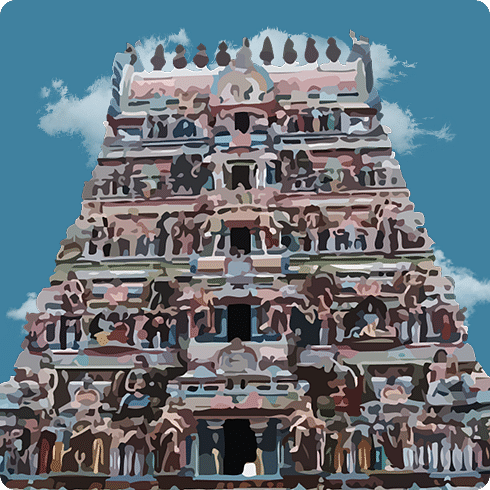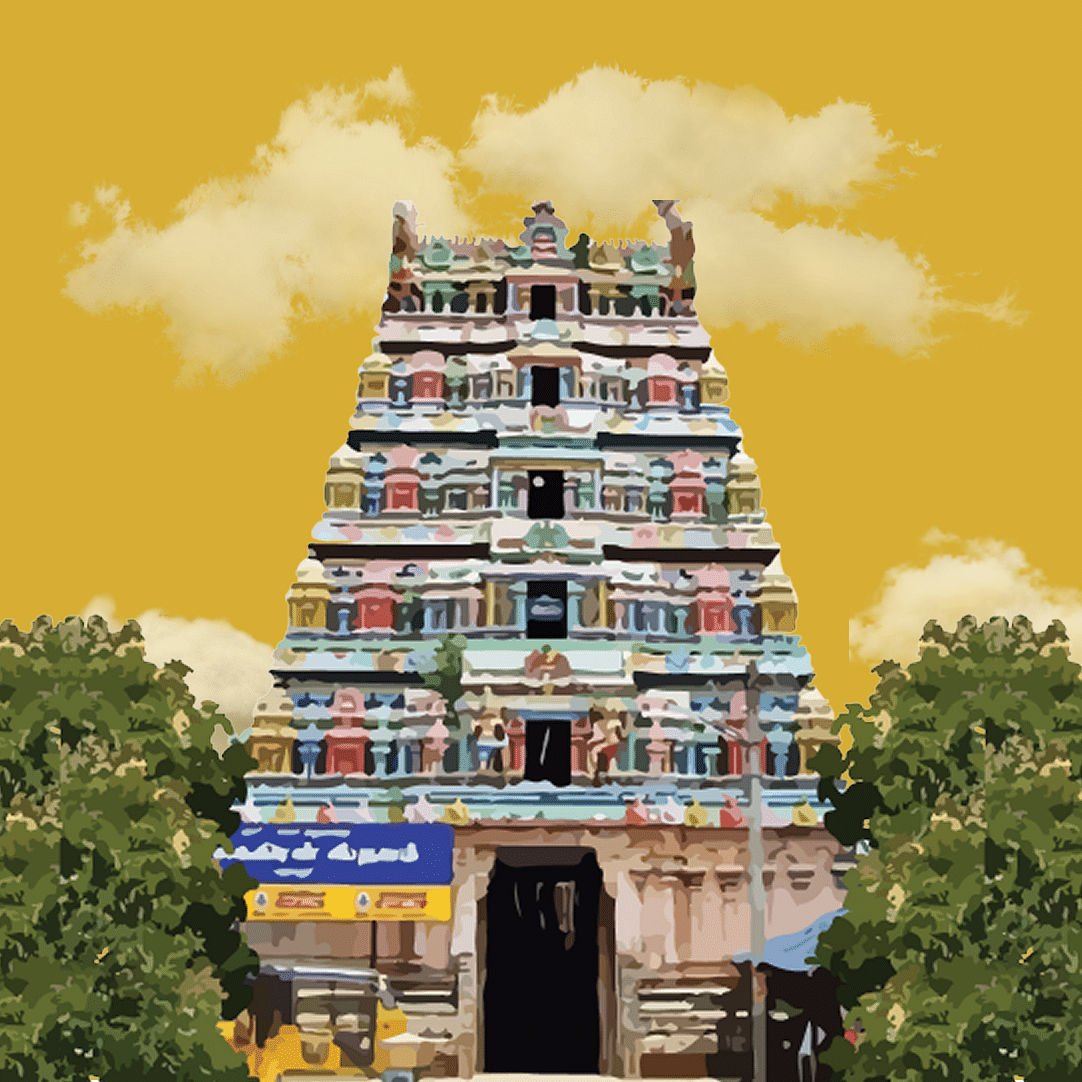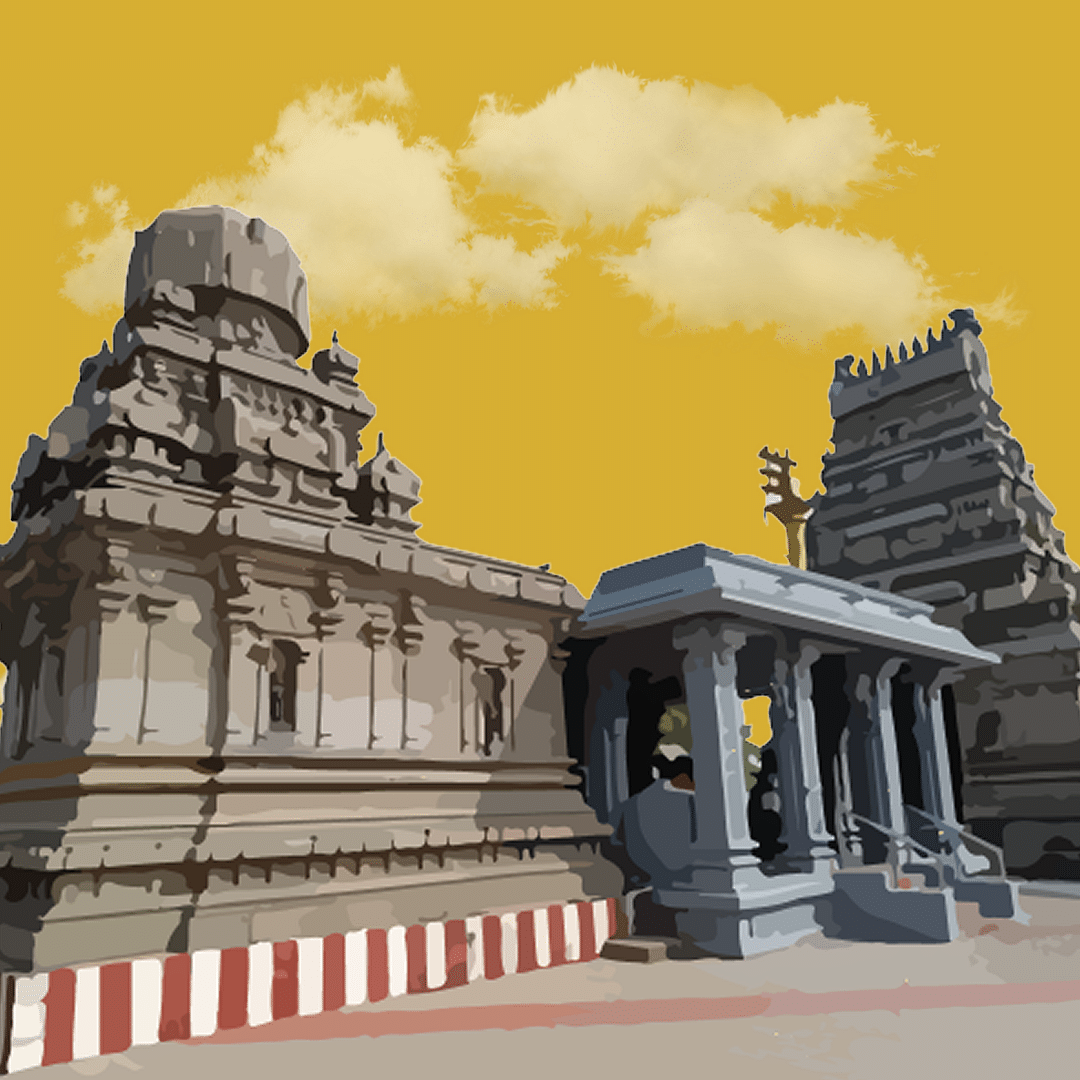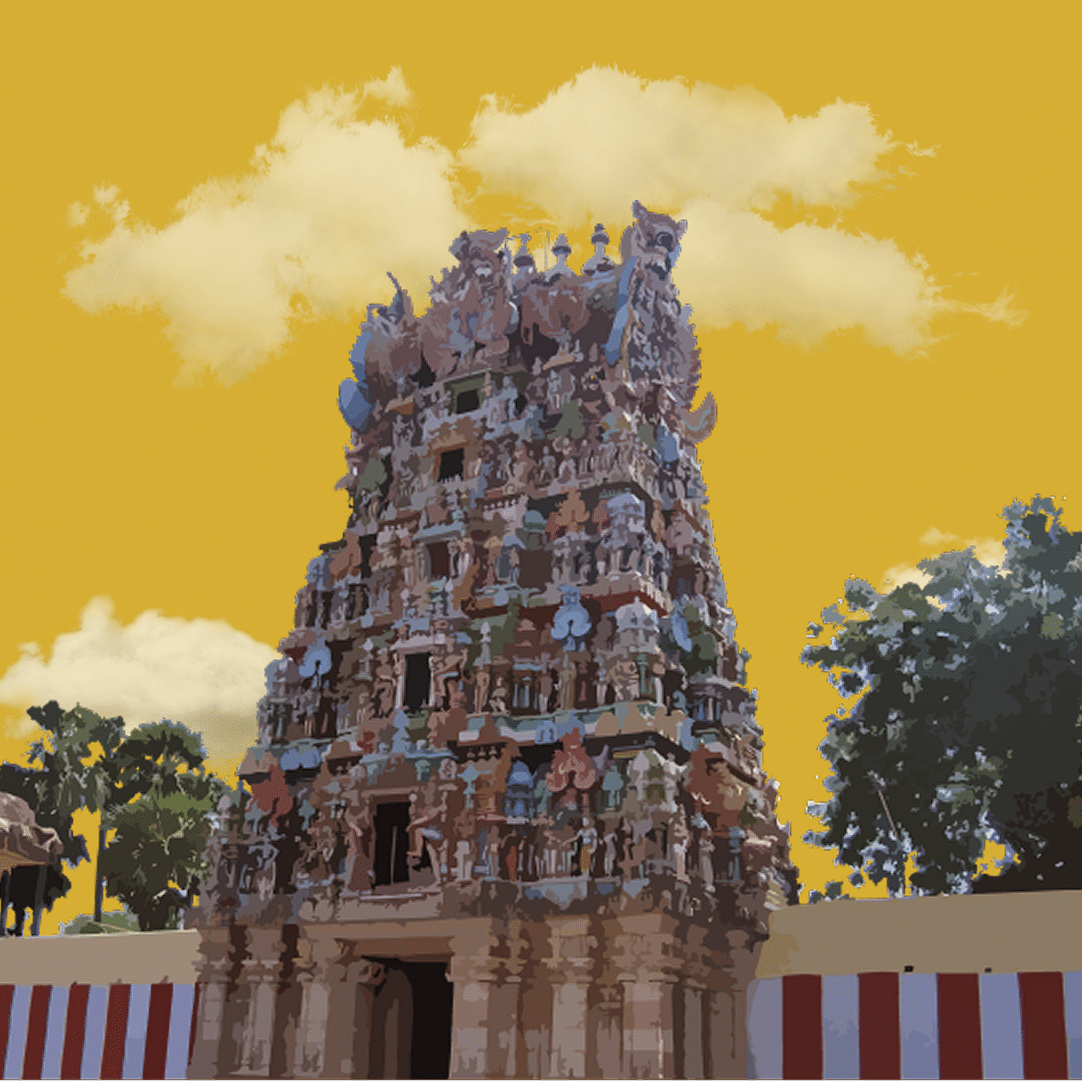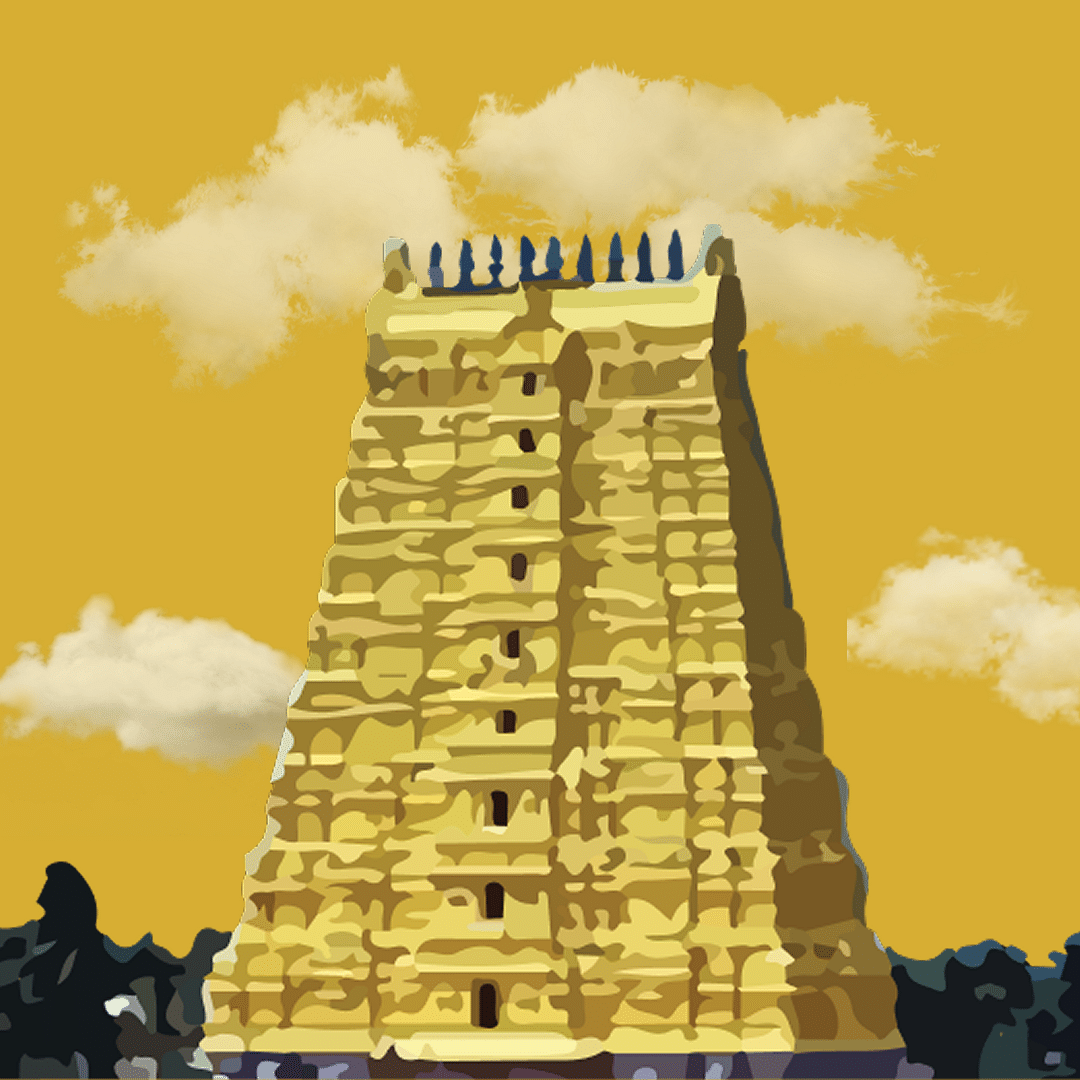Home > The GReaT Divine Darshan > Thanjavur
HOLY PLACES
IN THANJAVUR
Thanjavur doesn’t need to shout about its greatness—it’s the city that lets its temples, art, and history do the talking. At its core is the Brihadeeswara Temple, where a 216-foot tower stands so tall, it’s like the building had a personal growth spurt. And that 80-tonne capstone—just sitting there like it’s a casual afternoon. The city’s famous for Tanjore paintings that shine so bright, they make the sun jealous, while the air hums with the sound of Carnatic music like it’s part of the city’s DNA. If you're on the lookout for awe-inspiring temples in Thanjavur, you won’t be disappointed. Then there’s Thanjavur ponni rice—fluffy enough to make any meal feel like a royal feast. Walk through the streets, and you’ll find that history isn’t just something you read about—it’s something you breathe in, see in the art, and hear in the music. Thanjavur doesn’t just hold its past—it makes sure you feel it in every step.
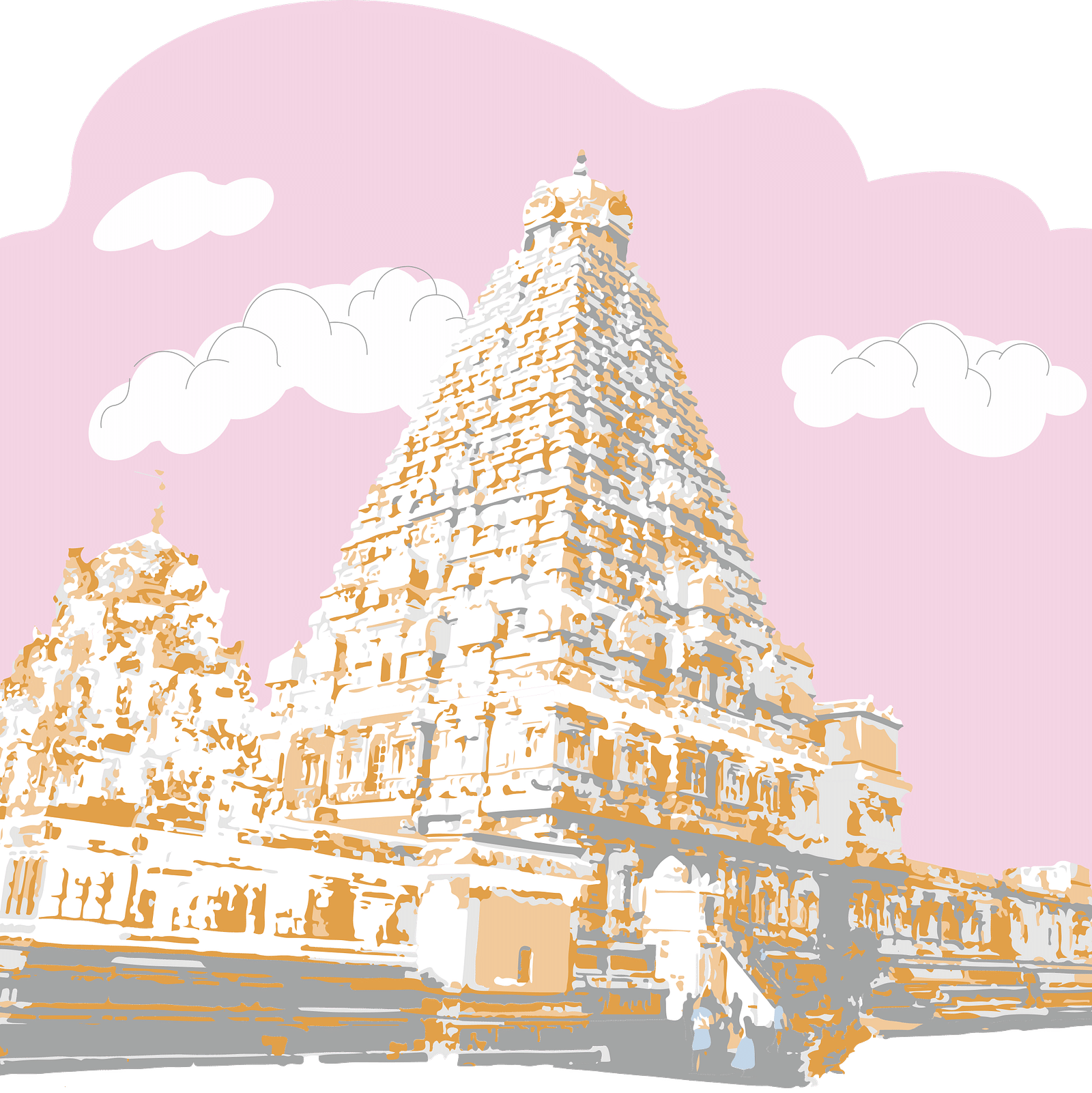
 OUR Hotels
OUR Hotels
IN THE CITY, BY THE SACRED SITES 🏙

GReaT Trails River view Resort Thanjavur By GRT Hotels
Planning your escape to Thanjavur? GReaT Trails River View Resort by GRT Hotels is your perfect base camp—right on the River Vennar, where the trees have heard more stories than your grandma’s old gossip sessions. Whether you’re here to marvel at the Brihadeeswara Temple or just to chill like royalty, we’ve got the spot. Hungry? Dhanyam’s farm-to-table dishes are so fresh, they might just start talking back to you. After a day of temple-hopping, if your feet are plotting their own rebellion, our spa will turn you into a puddle of relaxation. You’ll leave feeling like you’ve been pampered by a team of spa sorcerers. Oh, and did we mention we’re pet-friendly? Bring your furry sidekick for a riverside stroll—they’ll probably enjoy it more than you! Whether you’re here for the history, the comfort, or just the food that’ll make you wonder why you didn’t move to Thanjavur sooner, we’ve got you covered.
 OURDivine Destinations
OURDivine Destinations
TRAVEL THROUGH THE MUSEUMS OF FAITH 🛕
_626bebbd)
THANJAVUR BIG TEMPLE ✨
Over 1,000 years old, this grand temple built by Raja Raja Chola I stands as a masterpiece of Dravidian architecture and divine heritage!
Distance from Our Hotel8 km
Timing6:00 a.m. to 12:00 p.m.
4:00 p.m. to 8:30 p.m.FestivalBrahan Natyanjali Festival: (Feb-Mar)
Pongal: (Jan)
Margazhi Festival of Dance and Music: (Dec-Jan)
Thanjavur Chariot festival: (May)Sacred Food OfferedLaddu Adirasam
Transportation CostFor assistance, please contact the front desk.
Disclaimer: The temple's timings are subject to change as per the operating committee's decisions.
About Thanjavur Big Temple:
- It is the first-ever fully granite temple in the world, using over 1,30,000 tons of stone.
- The towering vimana (sanctum tower) stands at 66 metres (216 ft.), making it one of the tallest temple towers in India.
- A mystery that baffles researchers—its vimana’s shadow never falls on the ground, an architectural marvel.
- The temple’s Nandi (sacred bull), carved from a single rock, is 16 ft. long and 13 ft. high, making it the second largest in India.
- The temple complex features detailed inscriptions of Raja Raja Chola I’s victories and temple grants, offering deep historical insight.
- Brihadeeswarar Temple is among the 'Great Living Chola Temples', recognised as a UNESCO World Heritage Site.
- The temple’s main deity, Lord Shiva, is enshrined in one of the largest Shiva Lingas in India.
- Ashta-dikpalakas, the eight guardian deities of directions, are uniquely depicted in the temple’s architecture.
- Despite being over 1,000 years old, the temple’s structure has withstood time, wars, and natural calamities with minimal damage.
Divine Facts:
Once upon a time, in the golden era of the Cholas, King Raja Raja Chola I had a vision of Lord Shiva in all his divine glory. It is believed that before embarking on the grand construction of the Brihadeeswarar Temple, the king sought blessings at the sacred Chidambaram Nataraja Temple. Inspired by divine grace, he resolved to build a temple that would stand as a testament to Shiva’s supreme power and the grandeur of the Chola dynasty. Legends say that the temple’s magnificent vimana was designed in such a way that its shadow never touches the ground, a marvel that continues to mystify scholars and devotees alike. Even today, the temple stands as a beacon of devotion, whispering the tales of its glorious past through its towering granite walls. This divine tale is rooted in temple traditions and inscriptions but does not have an officially cited historical source. It is widely believed in Tamil oral traditions and temple folklore.THIRUVAIYARU TEMPLE ✨
Believed to be built by Emperor Priyaviradhan of the Sun Dynasty, this ancient Shiva temple in Thiruvaiyaru stands where five sacred rivers unite!
Distance from Our Hotel9 km
Timing6:00 a.m. to 12.00 p.m.
4:00 p.m. to 8:30 p.m.FestivalThiruvaiyaru Thyagaraja Music Festival: (Jan)
Saptha Stanam festival: (May)
The float festival: (Jan-Feb)
Appar festival: (Apr)Sacred Food OfferedLaddu
Transportation CostFor assistance, please contact the front desk.
Disclaimer: The temple's timings are subject to change as per the operating committee's decisions.
About Thiruvaiyaru Temple:
- Located near Thanjavur, Tamil Nadu, Thiruvaiyaru Temple is a revered and ancient spiritual site.
- The temple dates back over 800 years, showcasing the rich heritage of South Indian temple architecture.
- It reflects a unique blend of architectural styles from the Chalukya, Western Ganga, Pallava, and Vijayanagara dynasties.
- The temple is dedicated to the Pandavas—Dharmaraja, Bhima, Arjuna, Nakula, Sahadeva—their wife Draupadi, and Lord Krishna.
- A popular pilgrimage site, it attracts devotees and history lovers for its cultural significance and divine aura.
Divine Facts:
In the sacred town of Thiruvaiyaru—where five rivers don’t just meet, they throw a full-blown reunion party—stands a temple where Shiva isn’t just worshipped, He’s the headline act. Known as Aiyarappar or Panchanadeeswarar, He literally carries the name of the land itself: ai for five, aaru for river. The lineup? Vadavaru, Vennaaru, Vettaaru, Kudamuruttiyaaru, and the star of the show, Kaveri. Together, they don’t just quench the land—they flood it with legends. Now, once upon a pilgrimage, a devoted temple priest had his spiritual GPS set on Kashi. But mid-yatra, he realised he wouldn’t make it back in time for the daily pooja. Panic? Nope. He did what any seasoned devotee would do—he folded his hands, shut his eyes, and placed the entire pooja schedule in Shiva’s inbox (heartfelt prayer). The next day, villagers blinked twice when they saw the aarti had been performed perfectly. Suspicious? Maybe. Miraculous? Definitely. It turns out, Shiva himself had clocked in as a priest for the day. Now that’s divine multitasking. This land isn’t short on spiritual stardust. Saint Appar caught a full vision of Kailasa here. No buffering, no glitches. Just pure, blessed darshan. And Sundarar? He wanted to visit the temple across the river at Thirukkandiyur, but the Kaveri decided to pull a 'do not disturb' and flood the way. No boats, no bridges, just divine faith. Sundarar prayed, and the river parted the way to let him through. But wait, there’s more. Long before Nandi became Shiva’s ride, the divine bull was born right here. His father? Sage Salandha. His cradle? The temple courtyard. Left in the sanctum like a divine delivery, baby Nandi got the VVIP welcome—an ablution of breast milk from Goddess Ambika, foam from the baby bull’s own mouth (don’t ask), and sacred waters from Surya Pushkarni, Amrita Pushkarani, and Saiva Theertham. Five holy liquids, five rivers—coincidence? Nope. Divine math. Hence, the Lord here earned the name Aiyarappar: the Lord of the Five Waters. Inscribed in ancient stone, this temple was once called Loga Mahadevi Iswaram, and it still carries the echoes of saints, sages, and stories that refuse to fade. From river miracles to cosmic babysitting, Thiruvaiyaru isn’t just sacred—it’s stage-lit with myth, music, and the quiet grace of five rivers that remember every story they’ve ever heard._8ec8d0a1)
_c8bd4e2e)
THE SWAMINATHA SWAMY TEMPLE ✨
Believed to date back to the 2nd century BC and later rebuilt by a Chola king, this ancient hilltop temple is one of the six sacred abodes of Lord Murugan.
Distance from Our Hotel33 km
Timing6:00 a.m. to 12:00 p.m.
4:00 p.m. to 8:30 p.m.FestivalAadi Kirthigai: (Jul-Aug)
Vaikasi Visakam: (Jun-Jul)
Panguni Uthram: (Mar-Apr)
Thaipusam Festival: (Jan-Feb)
Kandha Sashti: (Oct-Nov)
Margazhi Poojai: (Dec-Jan)
Thiru Karthigai: (Nov-Dec)Sacred Food OfferedPanchamirtham
Transportation CostFor assistance, please contact the front desk.
Disclaimer: The temple's timings are subject to change as per the operating committee's decisions.
About Swami Malai:
- This is one of the six sacred abodes of Lord Murugan, known as the Arupadai Veedu, and it holds immense spiritual significance.
- The temple was originally built in the 10th century AD and later reconstructed by the Chola kings.
- It is renowned for its unique staircase of 60 steps, each one representing a year in the Tamil calendar cycle.
- The temple's architecture beautifully blends traditional Dravidian and Chalukyan styles, showcasing intricate craftsmanship.
- Major festivals celebrated here include Thai Poosam, Panguni Uthiram, Maha Shivaratri, and the Swaminathaswamy chariot festival.
- Swamimalai is located just 5 kilometres from Kumbakonam, making it easily accessible for pilgrims and tourists alike.
Divine Facts:
Long ago, in the sacred hills of Swamimalai, a moment of divine wisdom unfolded. It is believed that Lord Murugan, the son of Lord Shiva, took on the role of a teacher—a guru to his own father. When Lord Shiva asked about the meaning of the sacred mantra ‘Om’, it was Murugan who revealed its true essence. This powerful exchange of knowledge is known as Swaminatha Swami’s Upadesa. As per tradition, the teacher is always held in higher regard than the student. And so, Murugan’s temple was built atop a hill, rising sixty feet high. Devotees must climb 60 steps, each named after a year in the Tamil calendar, symbolising the passage of time and the shedding of past sins. Even today, each step is a reminder of that ancient lesson, echoing through centuries of faith and devotion.KASI VISWANATHAR TEMPLE ✨
Built in the 16th century during the Nayak period, this temple is dedicated to Lord Shiva, worshipped here as Kasi Viswanathar, alongside Goddess Visalakshi.
Distance from Our Hotel38 km
Timing6:00 a.m. to 12:00 p.m.
4:00 p.m. to 8:30 p.m.FestivalMasi Magam: (Feb-Mar)
Maha Shivaratri: (Feb-Mar)
Sacred Food OfferedMeva Laddoo
Transportation CostFor assistance, please contact the front desk.
Disclaimer: The temple's timings are subject to change as per the operating committee's decisions.
About Kasi Viswanathar Temple:
- It is one of the prominent Shaivite shrines located near the sacred Mahamaham Tank in Kumbakonam.
- The main deity, Lord Shiva, is worshipped as Kasi Viswanathar, while his consort Parvati is known here as Visalakshi.
- The temple is recognised as a Paadal Petra Sthalam, mentioned in the Tevaram hymns by the Nayanmars.
- The current structure was built during the 16th century under the rule of the Nayak kings.
- Devotees believe that prayers offered here help overcome delays in marriage, childlessness, and puberty-related concerns in young girls.
- The temple also features statues of the nine river goddesses (Nava Kannikas) who were blessed by Lord Shiva at this very site.
- It is believed that Lord Rama and Lakshmana received blessings here before their battle against Ravana, adding to the temple’s legendary importance.
Divine Facts:
Once upon a time, Lord Rama, known for his calm and noble nature, sought the fierce energy of Rudra to defeat Ravana in battle. Following sage Agastya’s counsel, he paused his journey in Kumbakonam to worship Lord Kasi Viswanathar. Through deep devotion, he gained the strength he needed—thus the place came to be known as Karonam, where courage met divinity. Elsewhere, the nine sacred rivers—Ganga, Yamuna, Godavari, Saraswati, Narmada, Tungabhadra, Krishna, Sarayu, and Cauvery—were burdened by the sins washed off by pilgrims. Seeking redemption, they turned to Lord Shiva, who directed them to the Mahamaham Tank in Kumbakonam. After their purifying dip, they prayed to Lord Kasi Viswanathar and requested him to remain there permanently for the benefit of mankind—an appeal the Lord graciously accepted. Today, their presence is honoured through majestic statues within the temple complex._d56d40bc)
_5dfb62e9)
ADI KUMBESWARAR TEMPLE, KUMBAKONAM ✨
Built in the 7th century and revered in the Tamil Saiva canonical work Tevaram, this temple in Kumbakonam is dedicated to Lord Shiva, worshipped here as Adi Kumbeswarar.
Distance from Our Hotel37 km
Timing6:00 a.m. to 12:00 p.m.
4:00 p.m. to 8:30 p.m.FestivalMahamaham: (Feb-Mar)
Theerthavari: (Feb-Mar)
Tirukalyanam: (May-Jun)
Tirumanjanam: (Jun-Jul)
Aadi perukku and Aadi Pooram: (Jul-Aug)
Panguni festival: (Mar-Apr)
Masi Magam: (Feb-Mar)
Sapthathanam (Apr-May)Sacred Food OfferedSweets, Fruits
Transportation CostFor assistance, please contact the front desk.
Disclaimer: The temple's timings are subject to change as per the operating committee's decisions.
About Adi Kumbeswarar Temple:
- The temple spans around four acres and follows a traditional Dravidian layout with three prakaras and four gopurams.
- The tallest, the eastern gopuram, stands at 128 feet with 11 storeys.
- The temple houses numerous shrines, including Mangalambigai Amman, Somaskanda, Subramanya with six hands, and the 63 Nayanmars.
- The main deity, Adi Kumbeswarar, is represented by a unique Lingam said to be formed by Shiva Himself.
- Look out for the intricately carved Navaratri Mandapam with all 27 stars and 12 zodiac signs sculpted onto a single stone.
- The temple is associated with the Mahamaham Tank, where the amrutham (holy nectar) is believed to have fallen.
- Festivals like Mahamaham (once every 12 years), Maha Shivaratri, Chithirai Brahmotsavam, and Thai Poosam draw thousands of devotees.
Divine Facts:
Long ago, when a great deluge threatened to end creation, Lord Brahma sought Lord Shiva’s guidance to begin anew. Shiva instructed him to create a pot with sacred sand collected from holy sites and set it afloat upon the cosmic flood. That pot eventually came to rest in Kumbakonam. In the guise of a hunter, Lord Shiva broke it open with an arrow, allowing divine nectar to spill and sanctify the land. From this, He emerged as Adi Kumbeswarar, and the sacred Lingam—believed to be formed from nectar and sand—became the heart of this revered temple. The name 'Kumbakonam' itself comes from this legend of the "Kumbha" (pot) and its divine origin.NAGORE DARGAH ✨
Built in the 16th century, the Nagore Dargah is a sacred mausoleum dedicated to the revered Sufi saint Shahul Hamid.
Distance from Our Hotel93 km
Timing4:00 a.m. to 7:00 a.m.
6:00 p.m. to 10:00 p.m. (on Fridays 12:00 p.m. to 2:20 p.m.)FestivalNagore Durgah Flag mounting: (Dec)
Uroos Mubarak: (Feb-Mar)
Ramzan: (Mar)
Bakrid: (Jun)Transportation CostFor assistance, please contact the front desk.
Disclaimer: The dargah's timings are subject to change as per the operating committee's decisions.
About Nagore Dargah:
- The principal shrine spans an area of over 217,000 sq. ft., with four monumental gateways in all cardinal directions.
- The Periya Minara or grand minaret stands 131 feet tall, built around 1760 AD by Pratap Singh, the Maratha ruler of Thanjavur.
- Within the golden-domed structure lie the tombs of Meeran Sahib, his son Syed Mohammed Yusuf, and his daughter-in-law Saeeda Sultana Biwi, each chamber adorned with silver doors.
- A pair of wooden slippers, believed to have belonged to Meeran Sahib, are preserved in a golden box and venerated by devotees.
- The Peer Mandap beside the dome is where the head of the dargah fasts during festivals.
- Regular Friday prayers in the adjacent mosque draw massive crowds.
- The Dargah has two satellite shrines: Vanjur, where Meeran Sahib meditated for 40 days, and Silladi, facing the Bay of Bengal.
- The shrine is now managed by the Dargah Trust, currently led by V.M. Shahul Hamid Sahib Washathari, the son of the famed 15th-generation descendant Alim Sahib Washathari.
- The book ‘The Ocean of Mercy’, originally written in Tamil by AR Syed Haja Mohideen, captures the miracles (karamat) of Meeran Sahib and has seen 17 reprints.
Divine Facts:
Centuries ago, Meeran Sahib, a descendant of the Prophet Muhammad, journeyed from North India, preaching peace and reform across the land. After performing Hajj and travelling through Kerala, he arrived in Thanjavur, where the then king, Achuthappa Nayakar, afflicted by a serious illness, sought his help. With divine grace, Meeran Sahib cured the king. In gratitude, the ruler donated land in Nagore, where the saint chose to settle. Over time, the place transformed into a sacred abode of miracles, drawing countless devotees. Even today, his presence is strongly felt, especially during festival times when his wooden slippers and the golden dome become focal points of prayer and reverence._c2677102)
_532dc0e4)
VELANKANNI MARY CHURCH ✨
Rooted in the 16th or 17th century, this sacred spot is where tradition says Mother Mary appeared with the Infant Jesus, turning the village into a global spiritual sanctuary.
Distance from Our Hotel99 km
Timing24/7.
FestivalAnnual Feast of Our Lady of Health: (Sep)
Public flag hoisting: (Aug-Sep)
Car festival: (Aug-Sep)
Feast mass: (Sep)
Easter: (Apr)
Christmas & New Year: (Dec)Transportation CostFor assistance, please contact the front desk.
Disclaimer: The church's timings are subject to change as per the operating committee's decisions.
About Velankanni Mary Church:
- The shrine is officially known as the Basilica of Our Lady of Good Health, and it stands as one of the most revered Marian shrines in the world.
- It is located in Velankanni, a coastal town in Tamil Nadu along the shores of the Bay of Bengal.
- Velankanni is often referred to as the 'Lourdes of the East', drawing comparisons to the famous pilgrimage site in France.
- The shrine welcomes millions of pilgrims every year, including people from different religious backgrounds.
- The church is open 24/7, offering devotees the chance to visit, pray, and seek blessings at any time.
- It is renowned for its Gothic-style architecture, serene ambience, and spiritually uplifting atmosphere.
- The shrine has gained fame for miraculous healings and answered prayers, especially for the sick and suffering.
- The history of the shrine is rooted in Marian apparitions that date back over four centuries, forming the foundation of its sacred status.
Divine Facts:
Long ago, on the quiet shores of Velankanni, a shepherd boy tending his sheep had a vision that would change the course of history. He saw a radiant Lady holding a child, who gently asked him for a cup of buttermilk. After he offered it, she told him to go to Nagapattinam and request a chapel be built in her honour—right where she stood. Miraculously, the boy, who had been lame, found his legs healed. Overwhelmed with joy, he carried out her wish. Inspired by this divine encounter, a humble thatched chapel was soon raised, marking the beginning of what we now know as the Basilica of Our Lady of Good Health. Since then, countless devotees have journeyed here, drawn by her love, her mercy, and the hope she continues to bring.RANGANATHASWAMY TEMPLE, SRIRANGAM ✨
Built in the grand Dravidian style, this temple is dedicated to Lord Ranganatha (a reclining form of Vishnu) and his consort Ranganayaki (a form of Lakshmi), making it a sacred site for Vaishnavites.
Distance from Our Hotel68 km
Timing6:00 a.m. to 7:30 a.m.
9:00 a.m. to 12:00 p.m.
1:15 a.m. to 6:00 p.m.
6:45 a.m. to 9:00 p.m.FestivalVaikunta Ekadasi: (Dec)
Car festival: (Apr)
Poochandi sevai: (Dec-Jan)
Jyestabishekam: (Jun)
Brahmotsavam: (Dec-Jan)
Tamil New Year: (Apr)
Margazhi Mahotsavam: (Dec-Jan)Sacred Food OfferedAkkaravadisal/Akkara Adisil
Transportation CostFor assistance, please contact the front desk.
Disclaimer: The temple's timings are subject to change as per the operating committee's decisions.
About Ranganathaswamy Temple, Srirangam:
- The temple spans an enormous area of 156 acres, making it the largest functioning Hindu temple complex in the world.
- It is enclosed by seven concentric walls, known as Prakarams, which symbolise the seven planetary systems in Vedic cosmology and reflect the layered approach to spiritual evolution.
- There are 21 elaborately decorated gopurams (entrance towers) within the complex. Each gopuram is adorned with intricate sculptures and carvings that narrate stories from Hindu mythology and epics.
- The Rajagopuram, which is the main entrance tower of the temple, rises to an impressive height of 236 feet, making it the tallest temple tower in Asia and a striking architectural marvel visible from several miles away.
- The temple is considered the foremost among the 108 Divya Desams, which are the most sacred Vaishnavite shrines dedicated to Lord Vishnu and celebrated in the Naalayira Divya Prabhandam, a collection of Tamil hymns composed by the Alvars.
- Within the temple, there are numerous mandaps (pillared halls), each uniquely designed and used for religious ceremonies, congregational worship, and spiritual discourses.
- The carvings and murals inside the temple not only exhibit extraordinary craftsmanship but also serve as visual scriptures, illustrating profound teachings and cosmic events from Hindu tradition.
- Historical evidence of the temple’s significance includes stone inscriptions dating back to 100 BC, confirming its continuous use and reverence through successive dynasties and eras.
Divine Facts:
Long ago, when Lord Rama ruled the kingdom of Ayodhya, he wished to gift something truly precious to Vibhishana, the noble-hearted brother of Ravana. It was no ordinary gift—it was his beloved deity, Lord Ranganatha, the reclining form of Lord Vishnu, resting on the great serpent Adisesha. With divine grace and reverence, Vibhishana began his journey back to Lanka, carrying the sacred murti and the vimana that sheltered it. As fate would have it, he stopped by the serene banks of the Kaveri River, in a land ruled by King Dharma Varma. Here, something divine unfolded. The deity, who had once travelled through the heavenly realms and kingdoms, chose this land—Srirangam—as His eternal abode. When Vibhishana tried to continue his journey, the deity remained still, His will firm. “This, He declared, is where I shall stay—facing south, watching over Lanka and blessing My devotee always". And so, nestled on an island between the sacred rivers, Lord Ranganatha lies in eternal repose, His presence filling the air with peace, devotion, and divine energy. Even today, as pilgrims pass through the towering gopurams and walk the sacred prakarams, they come face to face with that timeless moment—a moment when the Lord decided to rest not just in stone but in the hearts of millions.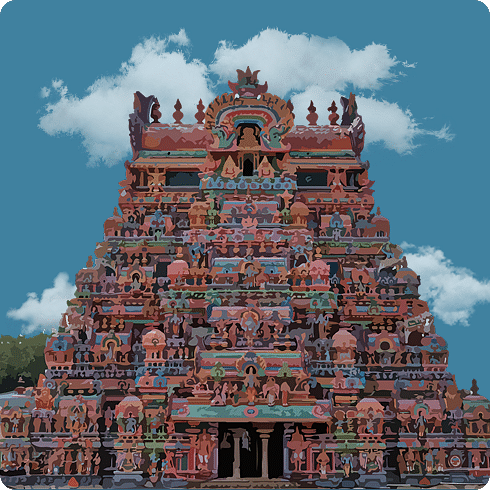
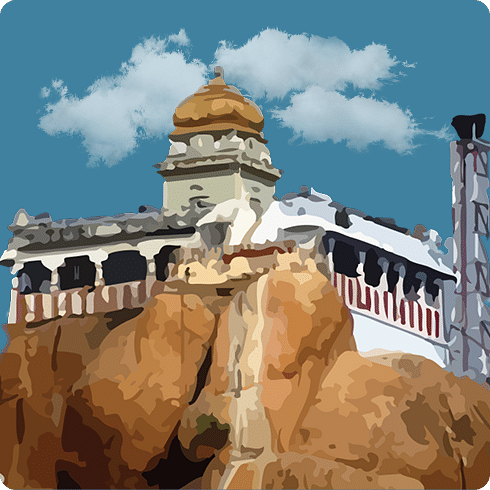
ARULMIGU UCHI PILLAIYAR TEMPLE ✨
Perched atop the iconic Rockfort Hill in Tiruchirappalli, Tamil Nadu, this temple is dedicated to Lord Ganesha and offers a unique blend of spirituality, history, and scenic beauty.
Distance from Our Hotel61 km
Timing6:00 a.m. to 12:00 p.m.
4:00 p.m. to 8:00 p.m.FestivalVinayaka Chaturthi: (Aug)
Panguni Uthiram: (Mar-Apr)
Karthigai Deepam: (Nov-Dec)
Thaipusam: (Jan)
Navaratri: (Sep)
Deepavali: (Oct-Nov)
Chitra Pournami: (Apr-May)Sacred Food OfferedKozhukattai
Transportation CostFor assistance, please contact the front desk.
Disclaimer: The temple's timings are subject to change as per the operating committee's decisions.
About Arulmigu Uchi Pillaiyar Temple:
- The Rockfort Temple is located in the centre of Tiruchirappalli, Tamil Nadu, approximately 1 km from Chathiram Bus Stand and 5 km from the Central Bus Stand.
- This temple complex is built atop a 275-foot-high rock formation, believed to be one of the oldest geological formations in the world.
- Devotees climb a flight of 417 stone steps carved into the rock to reach the summit where the shrine of Lord Ganesha, also known as Uchipillayar, is situated.
- Midway up the hill lies the Thayumanaswamy Temple, dedicated to Lord Shiva, which features a magnificent 100-pillared hall and ancient architecture.
- Inscriptions found within the temple date back to the 3rd century BC, highlighting its historical significance.
- From the summit, visitors are treated to breathtaking views of Tiruchirappalli, including the Cauvery and Coleroon rivers and the famous Srirangam temple complex.
- The temple is well-connected and can be easily reached via government and private bus services.
- It is closely linked to several local legends, including the story of Lord Vinayaka and the Asura king Vibishana, adding to its spiritual and cultural richness.
Divine Facts:
Long ago, during the epic events of the Ramayana, the noble Asura king Vibishana was gifted an idol of Lord Ranganatha by Lord Rama himself, as a token of gratitude. On his journey back to Lanka, Vibishana paused by the banks of the Kaveri to perform his daily rituals. But as divine fate would have it, Lord Vinayaka, in the guise of a playful cowherd, tricked him into placing the idol on the sand—knowing well that once placed, the idol could never be moved again. When Vibishana realised the boy’s divine trick, he struck him in anger, only to see Lord Vinayaka reveal his true form. Vibishana bowed in remorse, and the place where this occurred became the revered Rockfort, with the Ganesha shrine now known as Uchipillayar Temple. Not far below, another miracle unfolded. A pregnant woman, Rathnavathi, cried out in labour, alone and in pain. With her mother delayed, she had no one to help her—until Lord Shiva, moved by compassion, took the form of her mother and safely delivered her child. From that moment on, he was venerated as Thayumanaswamy—the Lord who became a mother. This beautiful act of divine grace still echoes in the hearts of devotees who climb the sacred steps seeking blessings.ARULMIGU JAMBUKESWARAR TEMPLE ✨
Built centuries ago, this prominent temple dedicated to Lord Shiva is located in Thiruvanaikaval, near Tiruchirappalli (Trichy), Tamil Nadu.
Distance from Our Hotel57 km
Timing6:00 a.m. to 12:00 p.m.
4:00 p.m. to 8:30 p.m.FestivalAadi Pooram: (Jul-Aug)
Panguni Brahmotsavam: (Mar-Apr)
Navaratri: (Sep)
Maha Shivaratri: (Mar)
Vaikasi Visakam: (May-Jun)Transportation CostFor assistance, please contact the front desk.
Disclaimer: The temple's timings are subject to change as per the operating committee's decisions.
About Arulmigu Jambukeswarar Temple:
- The temple represents the water element (Appu) in the Pancha Bhoota Sthalams.
- The Lingam here is Swayambhu (self-manifested) and is always surrounded by water from a natural spring.
- The shrine of Akilandeswari faces that of Lord Jambukeswarar, symbolising a teacher-student relationship between the deities.
- It is believed that worshipping here brings clarity, wisdom, and fulfilment of wishes related to education, marriage, and progeny.
- The temple was originally built by King Kochengot Chola and later expanded by the Hoysalas.
- Its narrow sanctum entrance, just 4 feet tall and 2.5 feet wide, was designed to prevent elephants from entering—linked to a fascinating legend involving a spider and an elephant.
- The Jambu tree, under which the deity resides, is said to be hundreds of years old and considered the temple's sacred tree (Sthala Vriksham).
- The temple is also known as 'Upadesha Sthala', owing to the divine teaching (Upadesha) of Shiva to Parvati.
Divine Facts:
Long ago, Goddess Parvati once playfully mocked Lord Shiva while he was deep in meditation. To atone for her actions, she was sent to Earth to perform penance. She chose the lush Jambu forest near the banks of the River Cauvery—what we now know as Thiruvanaikaval. There, under the shade of a sacred Jambu tree, she shaped a Lingam out of the river’s water and began her worship. Moved by her devotion, Lord Shiva appeared before her and, instead of accepting her as his consort, took the role of a teacher. Facing each other in the sanctum, he imparted deep spiritual wisdom to her. Thus, unlike many other temples where Shiva and Parvati are celebrated as divine partners, this temple honours them as Guru and Shishya—a teacher and a student. Adding to the temple’s divine aura, the Lingam Parvati created still remains here—eternally surrounded by water from a mysterious underground spring. This sacred presence of water, believed to have no known source, makes this site one of the holiest representations of the water element, and a rare marvel in both mythology and nature.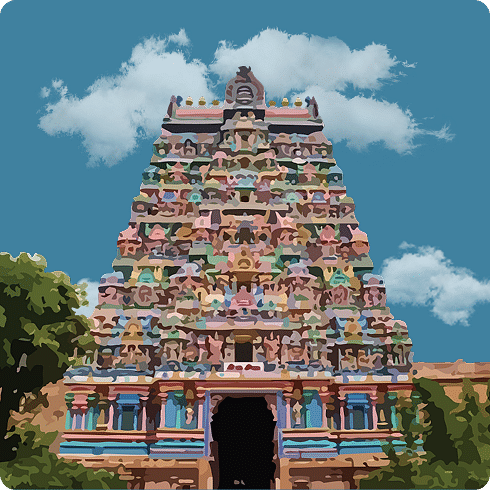
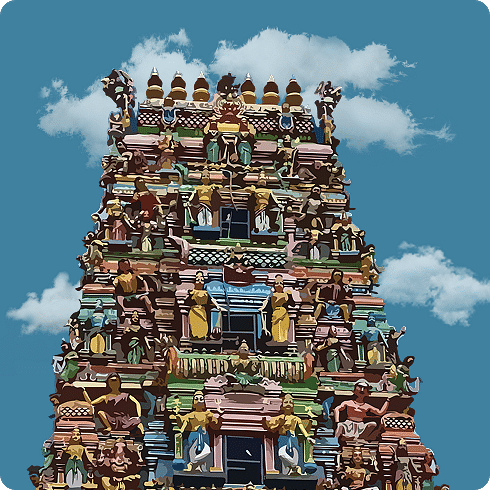
ARULMIGU SAMAYAPURAM MARIAMMAN TEMPLE ✨
Located in Samayapuram, near Tiruchirappalli (Trichy), this famous temple is dedicated to Goddess Mariamman and is one of the most revered shrines for the worship of the deity in Tamil Nadu.
Distance from Our Hotel63 km
Timing5:30 a.m. to 9:00 p.m.
FestivalPoochoridhal Festival: (Mar-Apr)
Panguni Uttiram: (Mar-Apr)
Thai Poosam: (Jan-Feb)
Aadi Festival: (Jun-Jul)Sacred Food OfferedPongal, Puliyodarai, and Sweet Pongal
Transportation CostFor assistance, please contact the front desk.
Disclaimer: The temple's timings are subject to change as per the operating committee's decisions.
About Arulmigu Samayapuram Mariamman Temple:
- The temple is regarded as the second wealthiest temple in Tamil Nadu after the Palani Murugan Temple.
- The main deity is called Samayapurathal and is made from a mix of sand and clay, which is why ablutions are not performed on the statue.
- An annual flower festival called Poochoriyal is held after the goddess observes a 28-day fasting period during the Tamil month of Maasi, during which she is only offered fruits and flour.
- Women devotees often donate their Mangalyam (Thali) as part of their prayer rituals.
- The temple features a massive resting hall for pilgrims who wish to stay and pray for healing over several days.
- The Urchavar idol (procession deity) currently used was donated in 1991 by devotees from Ulundurpet.
- One can view the main deity directly from the temple’s main entrance, a unique feature not common to many South Indian temples.
Divine Facts:
Long before the grand towers of Samayapuram rose to the skies, the idol of Goddess Mariamman quietly resided in the sacred halls of the Srirangam Sri Ranganathaswamy Temple. But something strange began to unfold—legend says that the temple priest fell ill, sensing an overwhelming power radiating from the goddess. Fearing her divine intensity, he requested the idol be removed. Left behind but never abandoned, the idol was soon discovered by villagers who felt her presence and chose to enshrine her in a humble spot in Kannanur. It was during this time that the Vijayanagara kings, preparing for battle, sought her blessings. They made a heartfelt vow—if they were victorious, they would build her a temple worthy of her might. They won. And so, true to their word, the magnificent Samayapuram Mariamman Temple came to life—a temple not just of worship, but of fulfilment, faith, and miraculous healing.SURIYANAR KOIL TEMPLE✨
Located near Aduthurai in the Thanjavur district, this renowned temple is dedicated to Bhagawan Surya and is the only Navagraha temple in Tamil Nadu with shrines for all nine planetary deities.
Distance from Our Hotel52 km
Timing6:00 a.m. to 12:30 p.m.
4:00 p.m. to 8:30 p.m.FestivalRatha Saptami: (Jan-Feb)
Sacred Food OfferedSakarai Pongal
Transportation CostFor assistance, please contact the front desk.
Disclaimer: The temple's timings are subject to change as per the operating committee's decisions.
About Suriyanar Koil Temple:
- The temple is located near the town of Aduthurai in the Thanjavur district of Tamil Nadu, India.
- It is one of the nine Navagraha temples in Tamil Nadu, forming part of the popular Navagraha pilgrimage route.
- The temple is uniquely dedicated to Bhagawan Surya, the Sun God, and is one of the few historic temples in India with this dedication.
- The main sanctum houses Bhagawan Suryanarayana in a standing charioteer form, accompanied by his consorts Usha Devi on the left and Pratyusha Devi (also referred to as Chaya Devi) on the right.
- Inside the sanctum sanctorum, the deity is also depicted in a reclining posture with his consorts, symbolising divine protection and repose.
- One of the murthis shows Bhagawan Suryanarayana with one hand in a protective gesture and the other hand resting calmly on his thigh.
- Unlike other Navagraha temples in Tamil Nadu, which are primarily dedicated to Lord Shiva, this is the only one where Surya is the presiding deity.
- The temple includes shrines for the other eight planetary deities, all of which are oriented to face the central sanctum of Surya.
- There are also shrines dedicated to Kasi Vishwanathar and Visalakshi within the temple complex.
- Architecturally, the structure includes a vinaanam resembling Surya’s celestial chariot, enhancing the thematic representation of the Sun God.
- The temple is believed to offer relief from Shani dosha (malefic influence of Saturn), making it a major destination for devotees seeking planetary remedies.
- It holds the distinction of being one of only two temples in India primarily dedicated to the Sun God—the other being the famous Konark Sun Temple in Odisha.
- Due to its rare dedication, religious significance, and connection to celestial worship, it is considered one of the most important Surya Sthalams in South India.
Divine Facts:
In the grand order of creation, when darkness still draped the universe like an unwashed curtain, Brahma decided it was time to let some light in. Thus was born Surya—the Sun—resplendent, radiant, and rather impossible to ignore. Wherever he went, shadows vanished, temperatures soared, and celestial beings reached for their sunshades. Surya was soon wedded to Usha Devi, also known as Sandhya, daughter of the celestial architect, Tvashta. She was luminous in her own right, and together they formed a brilliant pair. They had three divine children, but as the years rolled by, Usha discovered that marrying the Sun came with certain… climate concerns. Even divine endurance has its limits, and the ever-blazing presence of Surya proved to be rather too much. Choosing a quiet retreat over celestial combustion, Usha created her own shadow form—Pratyusha, later known as Chaya—and quietly retired to the forest for intense tapasya. Surya, engulfed in his own effulgence and perhaps unaware of shadowy subtleties, did not notice the switch and continued his duties with Chaya beside him. From this union, three more children were born—Shani, Tapti, and Savarni Manu. All seemed orderly until the truth emerged, casting a different kind of shadow over the tale. Upon learning that his original consort had withdrawn, Surya sought her out. His brilliance may light up worlds, but it took him time to see what had stood right beside him. Eventually, Usha returned, and the divine household found balance once more. Since then, both Usha and Chaya are venerated as the consorts of Surya. The rising sun is called Usha Kalam when the world stirs under her gentle grace. The setting sun is Saya Kalam, as Chaya ushers in dusk with a cooler presence. And so, the celestial rhythm continues—sunrise and sunset, light and shadow—each bearing witness to a tale of warmth, wisdom, and a rather elegant example of divine time-sharing._2833cb09)
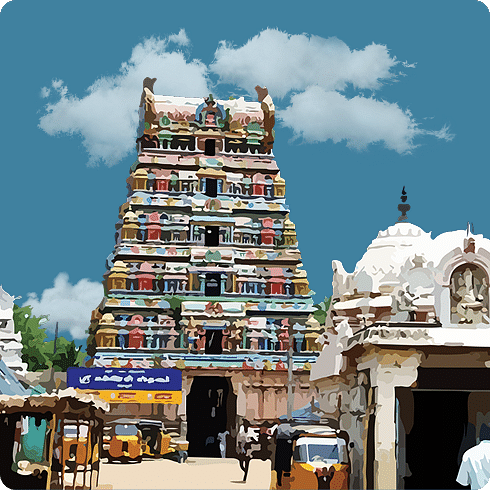
AGNISWARAR TEMPLE, KANJANUR ✨
Nestled in Kanjanur near Kumbakonam, this Navagraha temple is dedicated to Lord Shiva as Agneeswarar, uniquely worshipped as Shukra (Venus), blending divine grace with celestial significance in the sacred Cauvery Delta.
Distance from Our Hotel56 km
Timing6:00 a.m. to 12:30 p.m.
4:00 p.m. to 8:30 p.m.FestivalShukra Hora Pooja: Thisritual, performed during the hours of Venus is believed to help devotees alleviate the negative effects of Venue in their Horoscopes.
Chithirai Pournami: (Apr-May)
Maha Shivarathri: (Feb-Mar)Sacred Food OfferedSakarai Pongal
Transportation CostFor assistance, please contact the front desk.
Disclaimer: The temple's timings are subject to change as per the operating committee's decisions.
About Agniswarar Temple, Kanjanur:
- The temple is situated in Kanjanur, near Kumbakonam in Tamil Nadu, and is one of the nine Navagraha temples in the Cauvery Delta region.
- It is associated with Shukra (Venus), the sixth of the Navagrahas, and is specifically known as the Sukran Navagraha Sthalam.
- The temple is believed to have existed since ancient times and is revered as one of the Tevara Stalams, being the 36th in the series, located north of the river Kaveri in Chola Nadu.
- It is also referred to by several other names, including Palaasavanam, Bhrammapuri, and Agnistalam, highlighting its historical and spiritual significance.
- Unlike other Navagraha temples that have a separate shrine for each planetary deity, this temple is unique in that Lord Shiva Himself is worshipped as Shukra, and thus there is no individual sanctum for the planet.
- The presiding deities are Agneeswarar (Lord Shiva) and Karpagavalli Amman (Goddess Parvati), embodying the union of divine masculine and feminine energies.
- A notable feature of the temple is the lingam of Agneeswarar, which is said to absorb all the oil poured during abhishekam, a rare and mysterious phenomenon that adds to the sanctity of the shrine.
- The temple is believed to bestow blessings related to wealth, prosperity, love, and artistic expression—attributes governed by Shukra, especially for those facing planetary afflictions.
- Pilgrims and devotees continue to visit this temple to seek relief from the negative effects of Shukra dosha and to harness the planet’s beneficial energies.
Divine Facts:
In the grand celestial council of job assignments, Lord Shukra—planet Venus, torchbearer of luxury, wealth, art, and the occasional romantic entanglement—was always a bit of a show-off. While other planets had modest roles, Shukra came dressed in silks, quoting poetry and demanding rose-scented abhishekams. Naturally, he needed a place as refined as his reputation. And thus entered Lord Shiva—with the cosmic equivalent, didn’t just bless Shukra, he became Shukra. One might say it was the first documented case of divine job-shadowing, though in this case, the shadow was made of pure spiritual heat and glowing charisma. And speaking of heat, the temple’s lingam is famously thirsty. Not for power, praise, or Payasam—but for oil. Pour a pot over it and poof—gone. Not even a greasy shimmer left behind. It absorbs every drop like it’s on a lifelong detox programme.The main auditorium of this spiritual production is the Mukti Mandapam, where Shiva performed the Mukti Thandavam—a dance not just of limbs, but of liberation. When Sage Parashara showed up, hoping for a simple blessing, what he got instead was the full cosmic choreography. And then there’s the scene-stealer: Lord Dakshinamurthy. Usually found squashing the demon of ignorance underfoot, but here directly worshipping Haradatta Sivachariyar. It’s the divine equivalent of swapping out the villain for a devotee mid-play. Haradatta was no ordinary devotee. Originally a Vaishnava by the name of Sudarshana, he switched teams with the seriousness of a man changing mobile networks—except his plan involved public trials, spiritual debates, and some serious peer pressure. Today, his transformation is etched into the temple walls like a divine before-and-after testimonial.
TIRUNAGESWARAM NAGANATHAR TEMPLE✨
Located in Thirunageswaram near Kumbakonam, this temple is dedicated to Lord Shiva and Rahu. Known for its unique human-faced Rahu and divine legends, it’s a key Navagraha site believed to ease planetary afflictions.
Distance from Our Hotel47 km
Timing6:00 a.m. to 1:00 p.m.
4:00 p.m. to 9:00 p.m.FestivalWeekly rituals: The temple performs weekly rituals like Somavaram (Monday) and Sukravaram (Friday)
Annual Festivals: The Brahmotsvam or prime festival is celebrated for ten days in the Tamil month of Karthigai (November–December), Other yearly festivals include Kandashasti (Oct – Nov), Navaratri (Sep – Oct), and Vijayadashmi (Aug – Sep).
Rahu Peyarchi: A festival celebrated when Rahu changes his planetary placement, is another significant event.
Rahukalam Abhishekam: A noteworthy feature of the temple is the miracle that occurs during the Rahukalam abhishekam, where the milk poured on the Rahu murti is seen to turn blue.Sacred Food OfferedMilk Prasadam
Transportation CostFor assistance, please contact the front desk.
Disclaimer: The temple's timings are subject to change as per the operating committee's decisions.
About Tirunageswaram Naganathar Temple:
- The temple is believed to have been constructed during the reign of Aditya Chola I in the 10th century AD, marking its origins in the early Chola period.
- The inner mantapa was later established by Seikkizhar, a renowned Tamil scholar and devotee.
- The outer mantapa was added by Govinda Dikshitar, the minister of the Nayak rulers Achuthappa Nayak (1560–1614) and Raghunatha Nayak (1600–1634), reflecting the architectural influence of the Nayak period.
- In 1929, the western walls of the temple underwent renovations, which included the addition of decorative inscriptions.
- According to mythology, Adiseshan, Dakshan, and Kaarkotakan—serpents of great significance in Hindu lore—worshipped Lord Shiva here, giving the village its name ‘Tirunageswaram’.
- In another legend, Indra, cursed by sage Gautama for his misconduct, performed penance here by offering Punugu, a fragrant substance, to Giri Gujambigai for 45 days to seek forgiveness.
- Prominent sages such as Gautama and Parashara, and legendary kings like Bhagiratha and Nala, are also believed to have worshipped at this sacred site.
- The temple is one of the Navagraha Sthalams, specifically associated with the planetary deity Rahu, and holds an exclusive shrine for Rahu.
- A rare and unique feature is that Rahu is depicted with a human face, unlike the typical serpent-faced representations found elsewhere.
- The Rahu shrine is located in the south-west corner of the second prakaram, where Rahu is flanked by his consorts Nagavalli and Nagakanni.
- The temple showcases Dravidian architecture, featuring grand gopurams, elaborately carved pillars, and a 100-pillar mandapam with artistic detailing inspired by temple chariots.
- A nandavanam, or flower garden, can be found within the third prakaram, along with mandapas and a sacred water tank on the southern side.
- The main sanctum houses Lord Shiva as Naganatha Swamy, while Goddess Parvati, revered as Giri Gujambigai, is enshrined separately.
- The Goddess is considered Swayambu, or self-manifested, in the form of Meru, and hence, no abhishekam is performed for her ido
- It is believed that Maha Bhairava protects and supports the Goddess during her spiritual worship within the temple.
Divine Facts:
Long before GPS and Google Maps, the ancient serpents Adiseshan, Dakshan, and Kaarkotakan found themselves slithering towards salvation. Their destination? A sacred spot where Lord Shiva was known to take divine attendance without fail. Determined to shed a few lifetimes worth of karmic baggage, the trio coiled up at this very shrine, their spiritual retreat giving the village its rather serpentine name—Tirunageswaram. Because nothing says peace like three massive celestial snakes turning up for a group prayer. Meanwhile, in another cosmic subplot, Lord Indra, king of the heavens and occasional troublemaker, managed to land himself in hot water—again. Having taken too many liberties around sage Gautama’s hermitage (and more importantly, his wife Ahalya), Indra earned himself a top-tier curse. Not the kind that fades after a brisk puja, but the type that makes headlines in the celestial grapevine. Desperate to clear his divine name and resume his weather-related duties, Indra embarked on a penance marathon. For 45 days straight, he worshipped the goddess Girigujambigai with Punugu—the ancient equivalent of high-end perfume, reserved for only the most fragrance-forward deities. And Indra wasn’t alone in choosing this temple for a spiritual reboot. Legendary sages like Gautama and Parashara, perhaps checking in to ensure their curses were still active, also paid homage here. Even royal figures like Bhagiratha and Nala dropped by—inorder to bow before Naganathar, proving that when it comes to seeking blessings, even kings must queue. Thus, wrapped in sacred scent, cosmic redemption, and just the right amount of snake drama, this temple stands as a testament to how even gods have their off days.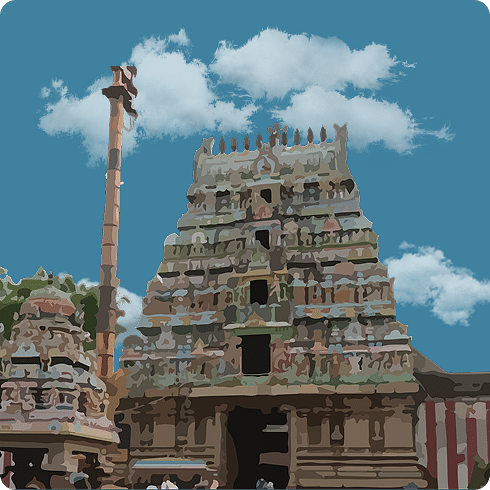
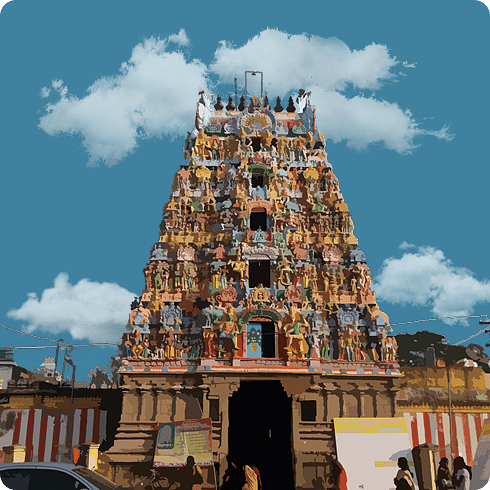
ARULMIGU ABATHSAGAYESWARAR TEMPLE ✨
When Shiva swallowed the deadly ocean poison to save the world, he earned the name Apatsahayesvarar—'Saviour in Crisis'. This heroic act sanctified Alangudi, where Guru (Jupiter) also blesses devotees as Dakshinamurthy.
Distance from Our Hotel43 km
Timing6:00 a.m. to 1:00 p.m.
4:00 p.m. to 8:30 p.m.FestivalGuru Peyarchi Festival:This is a major event, commemorating the movement of the planet Jupiter (Guru) between zodiac signs.
Brahmotsavam:(Apr-Jun)
Masi Maham:(Feb)
Chariot Festival:(May-Jun)
Chitra Pournami: (Apr-May)
Thai Poosam: (Jan-Feb)
Panguni Uthiram: (Mar-Apr)Sacred Food OfferedSakarai Pongal
Transportation CostFor assistance, please contact the front desk.
Disclaimer: The temple's timings are subject to change as per the operating committee's decisions.
About Abathsahayeswarar Temple:
- The temple is located in the heart of Alangudi, a prominent town in the Cauvery Delta region of Tamil Nadu.
- It is one of the nine Navagraha sthalas, specifically associated with Guru (Jupiter), who is worshipped here in the form of Lord Dakshinamurthy.
- The temple is revered for its association with the legend of Lord Shiva consuming poison during the Samudra Manthan (churning of the ocean), earning Him the name Apatsahayesvarar, the one who rescues in times of crisis.
- The five-tiered Rajagopuram (main entrance tower) is built with fine craftsmanship, reflecting traditional Dravidian architecture.
- Inside the temple, the balipeeta (altar) for Nandhi, Lord Shiva’s sacred bull, is covered with copper plates, a rare and symbolic feature.
- The inner prakara (corridor) houses shrines for various deities, including Kalangamal Katha Vinayaka, Muruga, Lakshmi, and the Nalvars — the four Shaiva saint-poets: Gnanasambandar, Tirunavukkarasar, Sundarar, and Manickavasagar.
- Seven forms of Shiva are enshrined under different names — Suriyeasar, Somesar, Gurumaswarar, Somanathar, Sabtharishinathar, Vishnunathar, and Brahmmesar — and are collectively known as the Sapthalingas.
- Additional shrines are dedicated to Kasi Viswanathar and Visalakshi, drawing parallels with the sacred city of Varanasi.
- Sage Agasthya is also worshipped within the temple premises, signifying his connection with South Indian Shaivism.
- The Sabanathar shrine contains the Tirumurai temple, where sacred Tamil Shaiva texts are preserved and honoured.
- The temple possesses large procession idols (utsava murthis) including those of Vinayaka, Subramanya, Chandeswara, and Kalyanasastha.
- The procession deity of Dakshinamurthy is uniquely depicted with four Sanakathi rishis, symbolising divine wisdom and the passage of knowledge through the ages.
Divine Facts:
When the Devas and Asuras teamed up for the ultimate cosmic tug-of-war—famously called the Samudra Manthan—they had one goal: to churn the ocean and bag a few divine goodies. Out came all sorts of treasures, including Kamadhenu, the wish-fulfilling cow, and even Lakshmi herself. But just as things were going splendidly, the ocean threw a tantrum and belched out a deadly poison known as Halahala. Now, this wasn’t your average garden-variety toxin. No antidote, no emergency herbs, not even a drop of turmeric milk could fix this one. With all of creation wobbling like a toddler on roller skates, everyone turned to the only being who had the stomach (and the throat) for the job—Lord Shiva. With zero hesitation and probably less regard for health warnings, Shiva gulped down the poison. Not a single burp, mind you. To contain its effect, Parvati gave him a divine throat-lock, which is how he ended up with that famous blue neck—Neelakantha style. Now, this little life-saving stunt didn’t go unnoticed. The location where Lord Shiva decided to pull off this act of cosmic bravery was later known as Alangudi, because apparently, it's the place where Shiva drank poison to save the world wouldn’t quite fit on a signboard. From that day forward, Shiva was fondly called Apatsahayesvarar—the Rescuer in Crisis. And then came Guru Bhagavan, the celestial planet Jupiter, who clearly fancied the aura. He settled here in the form of Dakshinamurthy, holding philosophical lectures under a banyan tree that somehow never had a leaf out of place.KAILASANATHAR TEMPLE✨
Built under the Pallava ruler Rajasimha around 700 AD, this temple earned the name Sand Temple for its sandstone structure. With 58 shrines surrounding a unique 16-sided Shiva Linga and early Dravidian murals, it stands as a rare blend of devotion, design, and historical depth.
Distance from Our Hotel14 km
Timing7:00 a.m. to 1:00 p.m.
4:00 p.m. to 8:00 p.m.FestivalMahasivarathri:(Feb-Mar)
Margazhi Thiruvadhirai:(Dec-Jan)
Panguni Uthiram:(Mar-Apr)
Thirukartigai:(Nov-Dec)Sacred Food OfferedAnna Prasanam
Transportation CostFor assistance, please contact the front desk.
Disclaimer: The temple's timings are subject to change as per the operating committee's decisions.
About Kailasanathar Temple:
- Around 700 AD, the temple was built during the reign of Pallava ruler Narasimhavarman II, also known as Rajasimha.
- It was constructed primarily using sandstone, giving it the local name Sand Temple, while its foundation was laid using granite for structural support.
- The temple showcases one of the earliest examples of classical Dravidian architecture, setting a precedent for later South Indian temple designs.
- It is one of the first temples in Tamil Nadu to feature mural artworks, offering rare insights into early South Indian painting traditions.
- The structure is square in plan and includes a grand entrance hall, a large mandapam or gathering hall, and a sanctum sanctorum crowned with a four-tiered Vimana.
- The main shrine is encircled by 58 small shrines depicting different forms of Shiva, with nine of these placed around the sanctum – seven outside and two inside.
- A striking feature of the temple is the 16-sided Shiva Linga made of black granite, deified in the central sanctum.
- The innermost circumambulatory passage symbolically represents the journey into and out of paradise, guiding the devotee spiritually.
- The main pedestal or Padabhanda Adisthana is richly carved with various deities, along with a sculpture of Nandi that faces and protects the main sanctum.
- The walls of the temple contain numerous inscriptions in early scripts, making it an important site for epigraphical and historical research.
Divine Facts:
Long before selfie sticks and souvenir shops entered temple courtyards, the Pallava king Narasimhavarman II—clearly a man with impeccable taste and zero patience for bland walls—decided that if Lord Shiva was to have a temple, it had to be nothing short of a cosmic gallery. So, around 700 AD, he rolled up his royal sleeves and gave the world what can only be called Shiva’s sandstone penthouse in Kanchipuram. Legend has it that this wasn’t just a place for divine presence, but a full-on celestial showroom. Shiva, in all his forms—peaceful, ferocious, meditative, and perhaps slightly dramatic—was to be represented here. So, around the sanctum, small shrines popped up like divine chess pieces, each flaunting a unique mood of the Lord. Calm Shiva. Dancing Shiva. Destroyer Shiva. Now, the main deity here isn’t your average granite statue. It’s a majestic 16-sided Shiva Linga. One can only assume that even geometry bowed before devotion. And right in front, there’s Nandi the bull, probably wondering how he got the front-row seat to all this architectural drama. And the mural paintings? They weren’t just divine doodles. These were the Pallava version of storytelling slideshows. Every brushstroke whispered stories of gods, cosmic battles, and possibly some temple gossip. And here's the twist: devotees who enter the temple can walk around the innermost path, which symbolises one’s spiritual journey through paradise. It's a sacred loop—enter humbled, exit enlightened. Or at the very least, impressed by the masonry. In summary: it wasn’t just a temple, it was Shiva’s grand sandstone stage. Where every carving sang, every wall remembered, and every pilgrim got a first-class ticket to architectural bliss—with Lord Shiva as the ever-stylish host.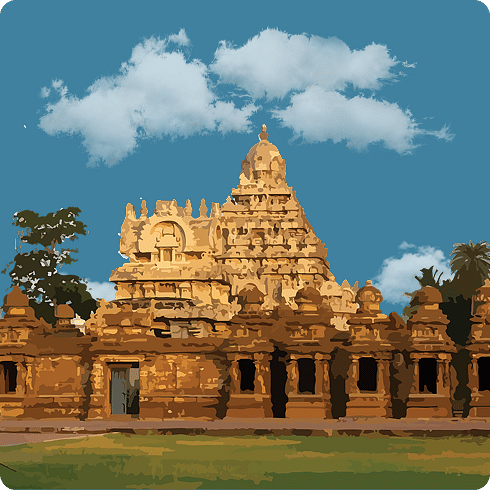
_27fcee88)
ARULMIGU NAGANATHASWAMY TEMPLE✨
At Arulmigu Naganathaswamy Temple, Lord Shiva is believed to have calmed the shadow planet Ketu. Devotees visit this sacred site to seek relief from karmic troubles and planetary doshas.
Distance from Our Hotel98 km
Timing6:00 a.m. to 12:30 p.m.
3:30 p.m. to 8:30 p.m.FestivalMaha Shivaratri:(Feb-Mar)
Panguni Vasuki Utsav:(Mar-Apr)
Karthigai Deepam:(Nov-Dec)
Navaratri:(Nov-Dec)Sacred Food OfferedDry Powder
Transportation CostFor assistance, please contact the front desk.
Disclaimer: The temple's timings are subject to change as per the operating committee's decisions.
About Arulmigu Naganathaswamy Temple:
- The temple is dedicated to Lord Shiva, worshipped here as Naganathaswamy.
- It is located in Keelaperumpallam, Tamil Nadu, and is one of the Navagraha temples, associated with Ketu.
- The temple follows the Dravidian style of architecture, with significant influence from the Chola period.
- Rajendra Chola I, the son of the great Raja Raja Chola I, was responsible for constructing this temple in the early 11th century AD.
- Portrait sculptures in bas-relief found within the temple depict the king and his queens, adding a personal and historical dimension to the temple's heritage.
- The temple inscriptions mention grants made by Rajendra Chola I in 1020 AD for daily worship by Shaiva Brahmanas.
- The Koshta sculptures, adorning the sanctum exterior, represent classic Chola craftsmanship with delicate detailing and religious significance.
- The temple’s Vimana features the vesara style, which blends elements of both Dravidian and Nagara architectural forms.
- Dwarapalaka (guardian) sculptures, which are typically present, are missing from the Koshta niches.
- Structural damages have affected the temple over time, including cracks in the ashlar stone lintels and beams of the Mukhamandapa, rendering the area unsafe for entry.
- The northern compound wall has collapsed, and the overgrowth of plant roots has caused serious structural issues in the vimana.
- The temple remains an important spiritual and architectural landmark, reflecting the glory of the Chola dynasty.
Divine Facts:
In the grand tapestry of the cosmos, where gods governed the stars and destinies were scribbled in celestial scripts, there lived a shadowy figure – Ketu. He wasn’t your typical planet. In fact, he wasn’t even a complete one. Born from a cosmic slice during the churning of the ocean, Ketu came into being as the tail end of an ambitious asura who dared to sip the nectar of immortality. The result? A divine beheading and a lifelong identity as a headless shadow planet. Now, being headless isn’t easy – especially when the universe expects you to govern karma, spirituality, and sudden surprises. With no eyes to see or mouth to complain, Ketu quietly shouldered his duties, but deep down, even celestial beings crave peace. Wandering across time and space in search of serenity, Ketu arrived at a sacred spot on Earth – Keelaperumpallam. The air here hummed with ancient chants, and the soil seemed to remember the footsteps of gods. It was here that Lord Shiva, in his benevolent form as Naganathaswamy, chose to grace the land. Surrounded by serpent symbolism and steeped in divine energy, the temple radiated a calm that even troubled planets couldn’t resist. Ketu, drawn to the aura of the place, took refuge here. It is said that the powerful vibrations of Naganathaswamy soothed his cosmic restlessness. No longer a misunderstood malefic force, Ketu found a sanctuary where his presence brought transformation rather than turmoil. And so, the temple became one of the sacred Navagraha shrines, with devotees visiting to appease Ketu, untangle their karmic knots, and find clarity amidst chaos. Whether battling mysterious delays, spiritual confusion, or simply the weight of their stars, pilgrims came seeking the grace that had once calmed even a shadow planet. In the heart of Keelaperumpallam, under the watchful gaze of Lord Naganathaswamy, a silent redemption unfolded – one that turned curses into calm, and a headless journey into a divine destination.THIRUNALLAR TEMPLE✨
At Thirunallar and Thirupamburam, Lord Shiva is believed to have eased the afflictions of Saturn, Rahu, and Ketu. Devotees visit these powerful shrines to seek relief from planetary doshas and find spiritual harmony.
Distance from Our Hotel93 km
Timing6:00 a.m. to 12:30 p.m.
4:00 p.m. to 8:30 p.m.FestivalMahashivaratri:(Feb-Mar)
Brahmotsav:(May-Jun)
Karthigai Deepam:(Nov-Dec)
Navaratri:(Nov-Dec)Transportation CostFor assistance, please contact the front desk.
Disclaimer: The temple's timings are subject to change as per the operating committee's decisions.
About Thirunallar Temple:
- The Thirunallar Temple is dedicated to Lord Shiva, worshipped here as Dharbaranyeswarar, and is located in the Union Territory of Puducherry.
- The temple's origins date back to the Chola period, around the 7th to 9th century AD, although the exact date of its initial construction remains uncertain.
- During the Chola dynasty's rule, the temple received generous patronage, with numerous inscriptions indicating grants of land, gold, and jewels for temple rituals and maintenance.
- The temple is one of the 275 Paadal Petra Sthalams, which were glorified in the Thevaram hymns by Tamil Saivite saints such as Tirugnana Sambandar, who is believed to have visited and sung praises of Lord Shiva here.
- According to legend, King Nala, afflicted by the malefic influence of Lord Shani (Saturn), regained his fortunes after bathing in the temple's sacred tank, the Nala Theertham, and praying to Lord Shiva and Lord Shani.
- Due to this mythological event, the temple became one of the Navagraha temples, specifically associated with Lord Shani, and gained prominence as a place to nullify the ill effects of Saturn.
- Over the centuries, the temple evolved architecturally and ritually, with various rulers and devotees contributing to its expansion and upkeep.
- The temple complex spans 15 acres, with three concentric walls, three gopurams, and a prominent eastern entrance tower built in the traditional South Indian Dravidian style.
- The main shrine houses a self-manifested Shiva Lingam covered in sacred Dharba grass, believed to have miraculous healing properties and spiritual energy.
- Adjacent to the main sanctum is the shrine of Lord Shani, with a tall, dark granite idol, flanked by his consorts and sons. Devotees offer oil, black sesame seeds, and black cloth to seek relief from Saturn's harsh influence.
- Every two and a half years, during Sani Peyarchi (Saturn's transit between zodiac signs), lakhs of devotees visit Thirunallar to perform special rituals and bathe in the Nala Theertham to ease their astrological burdens.
- Today, the temple remains one of the most visited pilgrimage sites in South India, renowned for both its spiritual significance and its historical and architectural grandeur.
Divine Facts:
Long ago, in a time when fate tested even the noblest of kings, there lived a righteous monarch named King Nala. Blessed with wisdom, grace, and a devoted queen, he ruled his kingdom with fairness and compassion. But the stars had a twist in store. The mighty planet Saturn (Shani) cast its shadow upon Nala’s life, and what followed was a storm of trials — he lost his kingdom, wandered in exile, and bore the weight of suffering with dignity. After years of enduring sorrow, King Nala reached a quiet village known as Thirunallar, where a sacred temple stood, nestled in what was once a forest of holy Dharba grass. Here, the king took a dip in the temple tank, later known as Nala Theertham. In that single, blessed moment, as the cool waters touched him, Saturn’s grip melted away. The heaviness in his soul lifted, and fortune returned like a long-lost friend. Overwhelmed, Nala entered the temple and offered his prayers to Lord Dharbaranyeswarar (Shiva). It is said that Lord Shani himself appeared, not in anger but in understanding. He explained that his trials were not punishments, but paths to spiritual evolution. As a mark of compassion, Shani granted a boon — that anyone who bathes in Nala Theertham and prays with a pure heart shall be freed from the burdens of Saturn’s influence. And thus, Thirunallar became not just a temple, but a celestial courtroom of redemption — where even planets pause, and grace flows freely through time and water._8c1ec183)
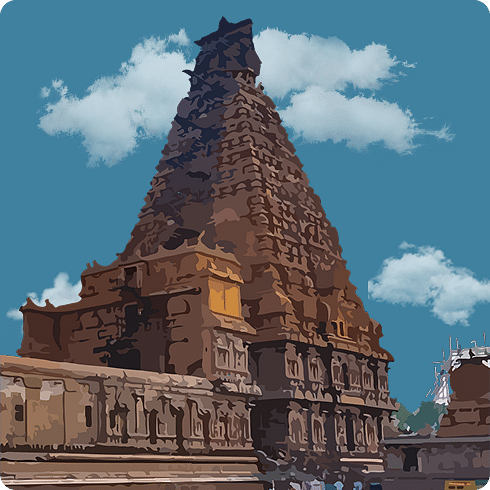
VAITHEESWARAN TEMPLE✨
Vaitheeswaran Koil, built over a thousand years ago, is renowned as the healing temple of Lord Vaidhyanatha Swamy where Mars was cured of leprosy. It is also sacred for Lord Rama’s rites for Jatayu and draws devotees seeking health and divine blessings.
Distance from Our Hotel90 km
Timing6:00 a.m. to 12:30 p.m.
4:00 p.m. to 8:00 p.m.FestivalPanguni Uthiram:(Mar-Apr)
Masi Magam:(Feb-Mar)
Vaikasi Visakam:(May-Jun)
Brahmothsavam:(Jan-Feb)
Maha Shivaratri: (Feb-Mar)Sacred Food OfferedThirusandurundai
Transportation CostFor assistance, please contact the front desk.
Disclaimer: The temple's timings are subject to change as per the operating committee's decisions.
About Vaitheeswaran Temple:
- The temple’s origins trace back to over 1,000 years ago, with contributions from the Chola dynasty, particularly during the reign of Kulothunga Chola II in the 12th century AD.
- It was constructed as a healing shrine, dedicated to Lord Vaidhyanatha Swamy, a form of Lord Shiva known as the Divine Healer, and His consort Thaiyal Nayagi Amman.
- According to legend, this is the site where Angaraka (Mars) was afflicted with leprosy and was miraculously cured after sincere prayers to Lord Shiva, which led to the temple’s identification as the Navagraha Sthalam for Mars.
- The temple is also associated with Lord Muruga, worshipped here as Selva Muthukumaran, and houses shrines for Vinayaka, Balambal, and Shiva Lingam, highlighting its multidimensional religious significance.
- In the Treta Yuga, as per the Ramayana, it is believed that Lord Rama performed the final rites of the noble vulture Jatayu at this very site, sanctifying the land through his divine act of honour and gratitude.
- Over the centuries, bronze idols of deities such as Nataraja, Angaraka, and Jatayu were added, enriching the temple’s spiritual and artistic legacy.
- The temple complex features a holy tank known as Siddhamirtham, believed to contain medicinal properties capable of curing diseases.
Divine Facts:
Once upon a cosmic crisis, Angaraka (Mars) caught a celestial case of leprosy. Desperate for a cure, he didn’t swipe left or right—he came straight to Vaitheeswaran Koil, where Lord Shiva moonlighted as the divine doctor. One heavenly prescription later, Mars was healed, and the temple became the go-to pharmacy for the universe’s toughest ailments. And just when you think it couldn’t get more legendary—enter Lord Rama, who honoured the brave bird Jatayu with sacred rites here, turning the soil into a sanctuary stamped with valour and virtue. Talk about a temple with multi-speciality blessings!THIRUVENKADU SWETHAARANYESHWARAR TEMPLE✨
Where divine rage met demonic chaos — Thiruvengadu is where Shiva took form as the fierce Agoramurthi to defeat evil. A temple wrapped in cosmic tales, sacred dance, and celestial blessings
Distance from Our Hotel98 km
Timing6:00 a.m. to 12:30 p.m.
4:00 p.m. to 8:30 p.m.FestivalVaikasi Visagam:(May-Jun)
Aaadi Mulaikattu:(Aug-Sep)
Navaratri:(Sep-Oct)
Aipasi Kolattam:(Oct-Nov)Sacred Food OfferedVen Pongal, Puliyodarai, Sakkarai Pongal, Curd rice
Transportation CostFor assistance, please contact the front desk.
Disclaimer: The temple's timings are subject to change as per the operating committee's decisions.
About Thiruvenkadu Swethaaranyeshwarar Temple:
- Thiruvenkadu, meaning ‘white forest’, is believed to be one of the most sacred places where Lord Shiva performed his cosmic dance – the Rudra Tandavam.
- The presiding deity, Lord Swetharanyeswarar, is believed to bless devotees with intelligence, wisdom, and eloquence.
- The temple is dedicated to Lord Budhan (Mercury), one of the Navagrahas, and is considered especially powerful for those seeking relief from Budha Dosham (Mercury affliction).
- The temple tank is known as Chandra Theertham, named after the Moon God, who is believed to have worshipped Lord Shiva here to rid himself of a curse.
- Three sacred rivers—Kaveri, Ganga, and Yamuna—are said to merge spiritually at this location, making a holy dip in the tank highly auspicious.
- The temple architecture features intricate carvings and inscriptions, some of which date back to the Chola dynasty, showcasing its historical significance.
- The Agora Moorthy shrine inside the temple is unique and rarely found elsewhere. The deity is depicted in an aggressive stance, signifying the fierce aspect of Lord Shiva.
- Thiruvenkadu is often compared to Kasi (Varanasi) due to its immense spiritual significance and the power of the deity worshipped here.
- Devotees perform Budhan Pooja on Wednesdays, wearing green-coloured attire and offering green pulses, to appease the planet Mercury and seek blessings for intellect and business success.
Divine Facts:
Once upon a very ancient time in the mystical land of Thiruvengadu, there lived a demon named Maruthuvasuran, who, for reasons only demons know, thought the best use of time was bothering saints and scaring innocent people. But before he turned into a public menace, Maruthuvasuran was actually quite the spiritual enthusiast. He sat under trees, chanted sacred mantras, and performed intense penance — all to impress none other than Lord Brahma. And it worked! Brahma, being the kind-hearted deity he is, granted the demon some very special powers. Big mistake. Instead of using those powers to start a nice organic farm or help out with temple renovations, Maruthuvasuran decided to become everyone's worst nightmare. Saints couldn’t meditate without being pranked, and peace-loving folks had to look over their shoulders all the time. It was pure chaos. Fed up, the desperate saints sent an urgent divine complaint to Lord Shiva. And Shiva, known for his cool temperament but legendary temper when riled, decided enough was enough. Enter stage left: Agoramurthi — Shiva’s no-chill, rage-fuelled form that means serious business. Think of him as the divine equivalent of a teacher storming into class when everyone's been throwing chalk. Shiva, as Agoramurthi, tracked down Maruthuvasuran, who, by the way, was still causing havoc under a tree, and gave him a cosmic smackdown. No negotiations, no second chances, just one swift divine justice moment. And that very spot? It's now the site of the Thiruvengadu Temple, where the energy of that legendary showdown still lingers. No wonder the place goes by names like Swetaranyam, Adi Chidambaram, and the Nava Nritiya Stala — the stage of nine sacred dances. Not to mention, it's had some pretty big celestial visitors: Indra, Airavata (his white elephant), Budhan, Surya, and Chandra all came here to pay their respects to Swetharanyeswarar. Divine VIP list, that.